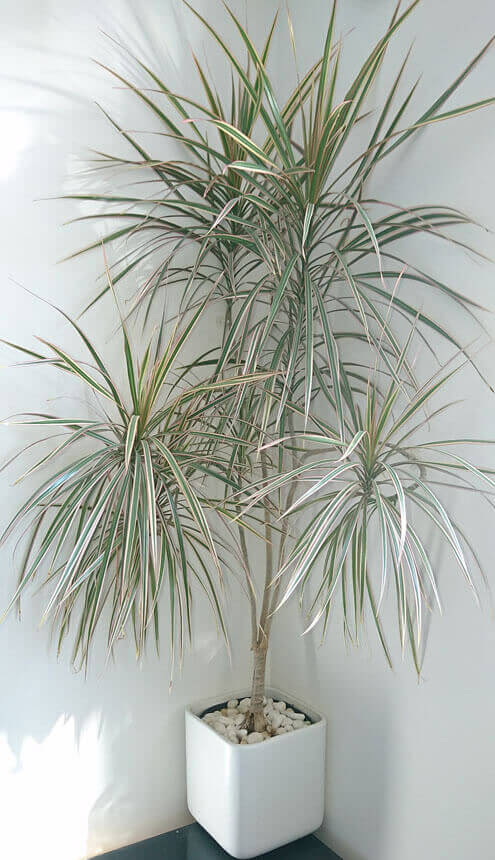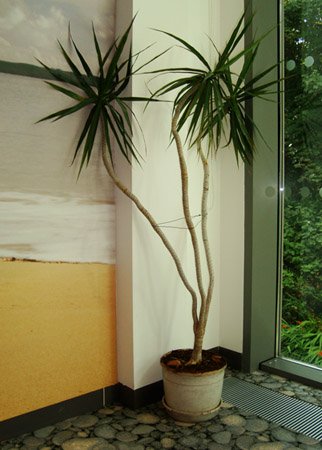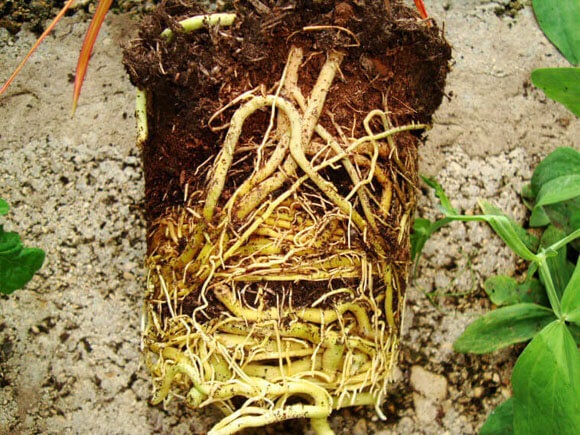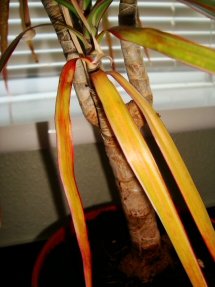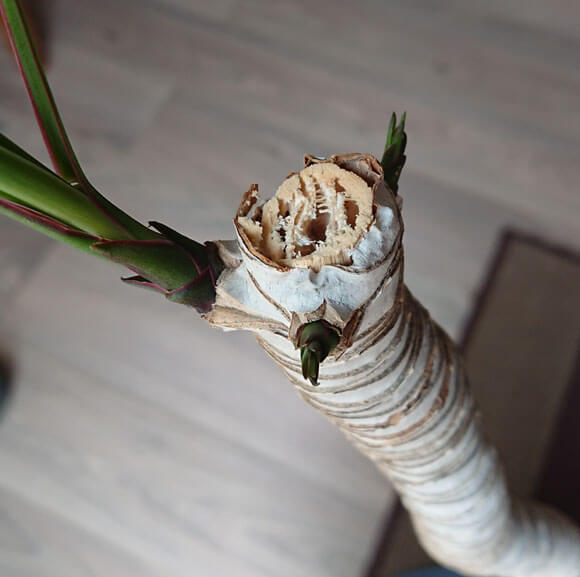The Madagascar Dragon Tree or Dracaena Marginata is just one of the many beautiful houseplants belonging to the Dracaena Genus.
They make great potted plants and although they can be slow growers, they're very long lived and their easy going nature means they should be long term houseguests.
Even though Dragon Trees can grow tall they don't need lots of root space
The common name "Madagascar Dragon Tree" is a combination of its native origin, "Madagascar" and its famous cousin Dracaena Draco (meaning Dragon). A plant that's well known for its tendency to ooze red blood like resin when cut or damaged, giving it an "alive" quality.
There is also an old legend that once a hundred-headed dragon was defeated and where it's red blood flowed, hundreds of Trees grew which locals at the time called Dragon Trees.
Before you go cutting your Dragon Tree looking for this mysterious blood, only D. Draco has the red resin whereas the common houseplant D. Marginata doesn't.
How do you pronounce Dracaena Marginata correctly? Say:
druh-SEE-nuh mar-jih-NAY-tuh
Like the other Dracaena varieties grown indoors, this houseplant has many advantages that make it fantastic to have around.
The first selling point is that it's still super popular today, even though it's been living in homes and workplaces since the 1960's it's escaped that dreaded "old fashioned" label.
The growth pattern is also an advantage because D. Marginata tends to remain quite slender and tall even after many years of growth and still looks great even when it's reaching its maximum indoor height.
The stems are stiff and sturdy so it can also fully support itself without any help from you. As it ages you might need to provide a little support if you're not happy with the direction the stems are hanging in.
Arguably this is one of the cheapest houseplants to buy and easiest to look after. Another perk is that the Dragon Tree will clean the air (a little bit) and is especially adept at filtering out xylene and trichloroethylene.
Finally, it also gives you a reasonable choice to pick from in terms of looks. Here are some of the more popular cultivars and varieties. Various d. marginata houseplant varieties.
Various d. marginata houseplant varieties.
The original Dragon tree. The leaves have a narrow red-purple like banding along the edges, with the central parts being a darker green (top picture).
Tricolor is the same as the original Marginata except it has three colours in its leaves. A band of yellow separates the light green from the edged red stripes, producing an overall greenish-gold effect (middle picture).
This is a modern cultivar, with the same growth pattern as the original (although perhaps a little slower) with the difference between the two being seen once more in the leaves. It mirrors the tricolor with the three colours on the leaves, except the red bands on the outside edges are much more prominent, creating an overall reddish or pinkish look (bottom picture).
Unlike the previous three, D. marginata 'tarzan' easily stands out as being quite different from the rest.
The leaves are the same colour as the original D. Marginata but they're quite a bit tougher, wider and slightly thicker. At the very top of each stem or cane, the leaves are laid out by the plant in an almost spiky ball shape (to us they look like the end of a Dragon's tail!).
New leaves emerge from the crown and initially point upwards. As they grow and are gradually replaced by newer leaves, the older leaves start pointing sideways, before reaching full maturity and finishing off by pointing downwards.
These downward facing leaves then yellow up and drop off, in this way the canes get longer and longer and the "balls" are able to "travel" upwards.
A large Dracaena marginata 'tarzan' - you can read all about its life towards the end of this article
While it's a unique and interesting looking houseplant, 'tarzan' unfortunately tends to be more expensive to buy which has negatively impacted its availability in shops. So if you like this variety, then be prepared to spend some time searching for it.
Whichever variety or cultivar you have, the care requirements are the same and we're going to go over these now for you.

Hi, I'm Tom!
If you're like me and enjoy the challenge of growing houseplants and getting them to thrive, then Ourhouseplants can help. This website shares my knowledge and years of growing plants and provides (hopefully) helpful advice on properly caring for your indoor plant friends.
Light shade is best for your Dragon Tree plant. Sitting on a North facing window ledge, close to an East / West facing window or some distance away from a South facing one are all good locations.
The leaves will scorch if it's too bright, and if it's too dark newer leaves will be small and limp looking.
Try to keep the soil moist (but never soggy or wet). A little dryness at the roots is better than risking overwatering. Make sure you cut back the watering in Winter as this is the prime time for plants to get the dreaded mushy soft stems.
Reasonable humidity is required. Often the humidity in the average home is perfect, but if you can, mist the leaves from time to time especially if the air is quite dry. The misting will also help remove any dust settling on the leaves.
If you have extreme brown tips forming, then you will need to find more effective ways to boost humidity levels because misting won't be enough.
To get new leaves sprouting regularly, you'll need to feed your Dragon Tree
To get new leaves sprouting on a regular basis you'll need to feed your Dragon Tree. Try and do it monthly in Spring and Summer. Sparsely in Autumn / Fall and none in Winter.
This plant does not like the cold. The room it lives in should never have temperatures lower than 10°C (50°F).
If you've put your plant outside for the Summer remember to bring it back indoors before any sign of frost. The temperature range for ideal growth is between 16°C (60°F) - 24°C (75°F).
Watch my YouTube Video for more visuals showcasing aspects of this plant that I couldn't capture in photos
You only need to repot when the roots are very congested and the plant is suffering as a consequence (little to no growth for several months is the most common sign). Unfortunately, the roots of the Dragon Tree grow exceptionally fast so if you follow this definition exactly, you may end up repotting twice a year! Instead, I would advise being a little cruel and only repotting every two years at most.
These plants can do well with very little root room. Take a look at the first picture in the article and in the gallery where you can see how big the plant is, even though it's in a small pot.
In my experience, Dragon Trees aren't fussy about the potting mix you choose to grow it in. Just make sure it's fresh and not too heavy. They're quite resistant to root rot, but if you're prone to this problem then think about using more "open" potting mixes.
I wrote an article about different Growing Mediums if you want to learn more about this topic.
The roots of a Dragon Tree are normally yellow(ish) and thick. This makes them better able to deal with overwatering and underwatering compared to many other foliage houseplants.
On occasion, you may find the large tap roots start to "coil" around and around the pot causing the root ball to rise up out of the container. If this happens, take the plant out of the pot and cut back some of the large thick tap roots before positioning what's left, back in the pot which should remove the "coil" effect.
There are three main ways to propagate a Dragon Tree and typically you can do all three methods at once to create multiple plants.
Propagation works best on an older plant because in time the canes will become longer or "leggy" as the leaf area shifts higher and higher up the plant. This gives you a lot of propagation material, which means you can:
Dragon Trees are quite slow-growing compared to other houseplants. However in Spring and early Summer they'll have fast spurts of growth at the crown which you'll definitely notice as the crown produces several leaves in succession.
The final height of your Dragon Tree depends on how tall your ceiling is!
The final height of your plant depends on how tall your ceiling is! To be fair, while natively they can reach 3m / 10ft or more, indoors you will probably run out of large enough pots to allow the plant to reach that size. So expect yours to only reach 2m / 6ft after many (many) years. No wider than 1m / 3ft.
Dragon Tree flowers are very rare and almost never seen on indoor plants. This is a houseplant grown for its foliage and architectural looks only.
The sap found within the leaves and stems does have small levels of a toxic substance that, while unlikely to be fatal, can cause irritation in people and pets when ingested.
If you've followed all the Dragon Tree propagation methods to increase your chances of getting at least one viable new plant, you could get lucky and end up with too many! Rather than throw them away, source a nice pot and give them away to friends and family.
Having the opposite problem and finding it difficult to actually find somewhere selling Dragon Trees? You could always try Amazon or have a read of our where to buy houseplants article for more inspiration.
Moderate Light Suitable plant for semi bright locations.
Moderate Watering Once or twice a week in Summer and once every two weeks in Winter.
Temperature Average indoor room temperatures. Never lower than 10°C (50°F)
Feeding Fertilize on a regular basis. None in Winter.
New Dragon Tree leaves are very small
Almost certainly too little light. A Dragon Tree won't give any thanks if you provide it with low light conditions over a long period of time.
Dragon Tree leaves falling off
If happening slowly over a number of weeks then this isn't a sign your Dragon Tree is dying, in fact it's showing you're treating it well!
The lower leaves of a Dragon Tree falling off
All Dracaena's are False Palms with a crown of leaves sitting at the top of their stems, new growth forms at the very tips of these stems, and the older leaves at the bottom of the crown will gradually yellow and fall.
This happens quite often and can be a bit shocking if it's the first time your plant has done it. But providing new leaves are forming too it's perfectly normal.
Leaves going yellow and falling off very quickly
As with the problem above, yellowing and falling leaves aren't usually an issue.
However if you're very concerned have a feel of the stems. If they're firm then it's very likely you've nothing to worry about. If the stems are very soft or squishy then read on to the next problem.
This has been caused either by giving far too much water over a prolonged period or from being exposed to very cold temperatures.
If this happens then your Dragon Tree is probably already dead and can't be saved in its present form. If any parts of the stem feel firm, or the leaf crown is intact you could try and propagate a replacement plant.
Going forward let the top half of the soil dry out before you water it again. Make sure you have a decent free draining potting mix and drainage holes to let water escape in case of accidental overwatering.
Leaves with brown spots
Usually a sign of underwatering. Try to keep the soil moist much of the time. If you would call the marks more like "blotches" than spots, it's caused by overwatering.
Leaves have brown tips and yellow edges
Often this is a symptom of dry air or cold breezes blowing near your plant.
Bleached dry leaves
Scorched leaves caused by too much light.
Mealybugs / Red Spider Mite
Mealybugs need to be treated with something like a cotton wool bud soaked in methylated spirit. Gently rub over the insects with the soaked cotton wool bud to remove them.
Red Spider Mite can be treated with an insecticide or if you'd prefer not to use chemicals, you can consider increasing the humidity for a few weeks or so, i.e. by daily misting.
I own several of these beauties, that all have unique stories. But what follows is probably my favorite.
My parents had a Dragon Tree "Tarzan" for as long as I could remember. Potentially they had it even before I was born.
Either way for years and years it had been steadily growing taller and wider in a conservatory. One late spring day during a mammoth cleaning of the conservatory, it was moved outside and as it seemed happy, it was left there.
Things were reorganised around its previous home and suddenly there was no way it was coming back into the house as its previous home had been filled with other things. Instead, it was left outside for the whole summer along with the gradually declining temperatures as late Autumn approached.
Pro Tip - If you read our article you'll know these plants do not cope with cold temperatures and if it approaches anything remotely sub-zero serious damage sets in.
With a cold night brewing one October, I decided to rescue it from certain collapse and take it to work. We had a staff area with floor to ceiling windows, which was perfect. And it settled in well (a young version of the plant just after its rescue is pictured in the article with the beach background).
Occasional knocks or damaged leaves were no problem as they always came back. I grew very fond of this plant because of it's tenacious and resilient attitude.
Almost 10 years later and I was made redundant, our entire office was due to close down so it was impossible to leave it in co-worker's care. As it was, there were so many houseplants around anyway (all my doing) I had to rehome so many as my home was already full and couldn't accept another 20 or 30 plants all at once.
This Dragon Tree was one of the largest and no one wanted it due to its size. It was a very stressful time in more ways than one.
At some point during the 10 years, it was happily living the office life, my parents had divorced and my mum had moved into a new place. When I told her what was happening she was happy to have it back.
Very pleased I'd found this plant a new home, I reunited it with its previous owner, all the while feeling confident it would be well looked after. I couldn't have been more wrong.
...feeling confident it would be well looked after. I couldn't have been more wrong.
A few weeks after it had settled in, as my mum tells it, an insect infestation storm happened and the plant was swarming with Fungus Gnats. As I had repotted it for her as part of its move, I wasn't too surprised as their eggs often lie dormant in bagged compost. I gave her some basic care tips for getting rid of them and thought no more of it.
She rang several weeks later one February evening telling me the plant looked finished. Fungus Gnats can be annoying but they never harm healthy plants, so I was a bit confused and thought she was exaggerating. I went around a week later to take a look and when I found out what she had done I was gobsmacked.
Firstly she was not exaggerating in the slightest. It did well an truly look bin worthy. With my experiences and history with this houseplant, I was upset at losing it. A few probing questions later and I discovered she had only gone and put it outside in the cold late winter temperatures!
I've told so many visitors previously never to give up hope on their plants, but even this was a hard sell I thought, as the mushy leaves came away in my hand. With a heavy heart, I removed the upper branches and all leaves, leaving just three fairly solid stems.
I also took cane cuttings to try and propagate more plants. All the cuttings rotted or didn't "take". At this point, I accepted things were over and moved on with life. A month later my mum texted me a picture, saying "Look!!!". On the main plant stems new sprouts had appeared. Life will always find a way.
Even when things look hopeless new life can find a way. Dracaena marginata plants are very tough and can resprout from leafless stems like this.
Don't let this wobbly experience put you off. I still have two fully grown and aged Dragon Tree plants (20 years old or more now) and they're easy if treated correctly. Follow my care instructions laid out above and you should be fine.
Credit for Dracaena marginata 'Colorama' - Article - Sunshine Tropical
Credit for Dracaena Marginata flower - Gallery - Forest & Kim Starr
Credit for compact Madagascar Dragon Tree - Gallery - BotBin
Credit for compact Madagascar Dragon Tree Tarzan - Gallery - Piotrus
